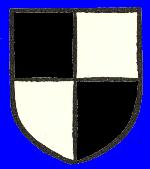
Hoo coat of arms
The Manor of Luton Hoo is not mentioned in the Domesday Book and the first reference to it in the surviving historical record is in 1245 when Thomas de Hoo conveyed land to his father Robert. In 1292 a Robert de Hoo received a charter of free warren for his Manor of Hoo and in 1306 he conveyed the manor to his son, another Robert, who in 1319 leased it at £10 per annum to his mother Hadwise de Goushill.
In 1337 Thomas de Hoo, son of Robert, held the manor and in 1391 his widow, Isabella held it. William, son of Robert and Isabella, was dead by 1415 as his widow Eleanor held the manor. And conveyed it to her son Sir Thomas de Hoo, who took an active part in the wars with France, being created Baron of Hoo and Hastings in 1447. He died in 1455 and his half brother Thomas succeeded him. This Thomas died in 1486 and Sir Thomas’ four daughters Anne, wife of Geoffrey Boleyn, Eleanor, wife of Sir Richard Carewe, Elizabeth, wife of Richard Devenish and Anne, wife of Roger Copley inherited the manor jointly.
About 1523 the manor was sold to Richard Fermor, but he forfeited it to the Crown due to his assistance to a convict named James Thayne. However, in 1551, Thayne managed to recover the manor. A Jeremiah Thayne held the manor in 1559 but by 1594 it had passed to Sir John Brocket, when it was sold by his trustees to Sir Robert Napier, who acquired Luton Manor in 1611.

Napier coat of arms
He died in 1637 and Luton Hoo passed to his son Robert Napier. He was an MP, first for Weymouth [Dorset] then Peterborough [Northamptonshire] and took the King's side during the First Civil War (1642 to 1646]. Parliament sequestered his estates in 1644 but was allowed to retain them in 1647. He died in 1660 having, in 1653, acquired both Woodcroft and Woodcroft alias Halyards Manor, the shares of the medieval Luton Manor of Sybil de Bohun and Eleanor de Leyburne. Thus he now owned the whole of the medieval manor, although both Woodcroft and Woodcroft alias Halyards retained their own separate identities.

Wernher coat of arms
Robert Napier was succeeded by his grandson, another Sir Robert, like his grandfather, who died without issue in 1675 leaving his uncle John as his heir. John Napier died in 1711 and was succeeded by his son Theophilus, who died without issue in 1719. His nephew John Napier succeeded and died in 1748, leaving the Luton estate to his aunt Frances, who devised it to her nephew Francis Herne who sold it to John Stuart, 3rd Earl of Bute in 1764. Bute was prime minister for just under a year from May 1762 to April 1763, having lost the confidence of King George III (1760 to 1820). He had the country house of Luton Hoo built by Robert Adam between 1767 and the 1770s. He was succeeded by his eldest son John, 1st Marquess of Bute on his death in 1792. The marquess died in 1814 and was succeeded by his grandson John Crichton Stuart as 2nd Marquess of Bute.
The 2nd Marquess sold his Luton estate in 1844 to a man named Charles Thomas Warde. Colin Perry provided us with information that helived at Clopton House, Stratford-upon-Avon [Warwickshire] and was High Sheriff of Warwickshire in 1846. Warde sold the manor in 1848 to John Shaw Leigh who died in 1871 and was succeeded by John Gerard Leigh, who on his death in 1875, was succeeded by his widow, later Madame de Falbe and, on her death in 1899, John Gerard Leigh's nephew succeeded, only to die within a fortnight leaving an infant son, whose trustees sold the manor, including Luton Hoo, to Sir Julius Wernher, a German born banker, in 1903. He died in 1912 and was succeeded by his son Sir Derrick Julius Wernher who died in 1948. However, a succession of Law of Property Acts in the 1920s effectively abolished manors in all but name, including copyhold land and manorial courts and income.